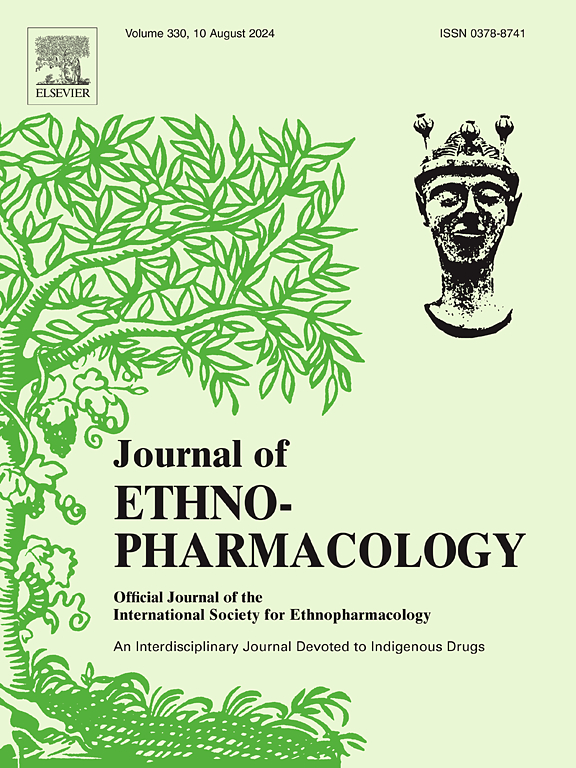Gu Han Yang Sheng Jing improves major depressive disorder via attenuating neuroinflammation by inhibiting AKT1/p65 signaling pathway based on network pharmacology analysis and experimental validation
IF 5.4
2区 医学
Q1 CHEMISTRY, MEDICINAL
引用次数: 0
Abstract
Ethnopharmacological relevance
Previous studies indicate that Gu Han Yang Sheng Jing (GHYSJ) exhibits neuroprotective properties in the central nervous system, but the protective effect of GHYSJ on major depressive disorder (MDD) and the precise mechanism underlying its protective effects remains unclear.
Aim of the study
This study aimed to clarify the antidepressant role of GHYSJ in MDD and the precise mechanism underlying via network pharmacology and experimental evaluations.
Materials and methods
Compounds-target-disease and protein-protein interaction network were constructed by network pharmacology to predict the potential targets of GHYSJ for the treatment of MDD. Molecular docking was used to predict the binding affinity between active components and pivotal targets. Protein expression levels were quantified via western blot analysis. The levels of proinflammatory factor were measured using ELISA kits. Immunofluorescence staining was performed to quantify Iba-1-positive cells. The antidepressant role of GHYSJ in MDD was tested by depression-like behavioral tests.
Results
This study identified a total of 94 active compounds and 185 targets of GHYSJ associated with MDD. Functional enrichment analyses revealed that inflammatory-related signalling pathways may be involved in GHYSJ-against MDD. Molecular docking demonstrated high-affinity binding between quercetin and TNF receptors. Furthermore, GHYSJ attenuated depressive-like behaviors of chronic unpredictable mild stress (CUMS)-exposed rats, reduced neuroinflammation, and inhibited the AKT1/p65 signaling pathway in the hippocampus of CUMS-exposed rats, which was reversed by the treatment of SC97 (AKT1 activator).
Conclusion
Taken together, These results suggest that GHYSJ improves MDD via attenuating neuroinflammation by inhibiting AKT1/p65 signaling pathway.

顾寒养生静通过抑制AKT1/p65信号通路减轻神经炎症,改善重度抑郁症基于网络药理学分析和实验验证。
民族药理学相关性:既往研究表明顾寒养生静(GHYSJ)对中枢神经系统具有神经保护作用,但其对重度抑郁症(MDD)的保护作用及其确切机制尚不清楚。研究目的:本研究旨在通过网络药理学和实验评估,阐明GHYSJ在重度抑郁症中的抗抑郁作用及其确切机制。材料与方法:通过网络药理学构建化合物-靶点-疾病和蛋白-蛋白相互作用网络,预测GHYSJ治疗重度抑郁症的潜在靶点。分子对接用于预测活性成分与关键靶点之间的结合亲和力。western blot检测蛋白表达水平。采用ELISA试剂盒检测促炎因子水平。免疫荧光染色定量iba -1阳性细胞。通过抑郁样行为测试检测GHYSJ在MDD中的抗抑郁作用。结果:本研究共鉴定出94种与MDD相关的GHYSJ活性化合物和185个靶点。功能富集分析显示,炎症相关信号通路可能参与ghysj抗MDD。分子对接显示槲皮素与TNF受体之间具有高亲和力结合。此外,GHYSJ可减轻慢性不可预测轻度应激(CUMS)暴露大鼠的抑郁样行为,减少神经炎症,抑制CUMS暴露大鼠海马中AKT1/p65信号通路,而SC97 (AKT1激活剂)可逆转这一现象。结论:综上所述,这些结果表明GHYSJ通过抑制AKT1/p65信号通路减轻神经炎症来改善MDD。
本文章由计算机程序翻译,如有差异,请以英文原文为准。
求助全文
约1分钟内获得全文
求助全文
来源期刊

Journal of ethnopharmacology
医学-全科医学与补充医学
CiteScore
10.30
自引率
5.60%
发文量
967
审稿时长
77 days
期刊介绍:
The Journal of Ethnopharmacology is dedicated to the exchange of information and understandings about people''s use of plants, fungi, animals, microorganisms and minerals and their biological and pharmacological effects based on the principles established through international conventions. Early people confronted with illness and disease, discovered a wealth of useful therapeutic agents in the plant and animal kingdoms. The empirical knowledge of these medicinal substances and their toxic potential was passed on by oral tradition and sometimes recorded in herbals and other texts on materia medica. Many valuable drugs of today (e.g., atropine, ephedrine, tubocurarine, digoxin, reserpine) came into use through the study of indigenous remedies. Chemists continue to use plant-derived drugs (e.g., morphine, taxol, physostigmine, quinidine, emetine) as prototypes in their attempts to develop more effective and less toxic medicinals.
 求助内容:
求助内容: 应助结果提醒方式:
应助结果提醒方式:


